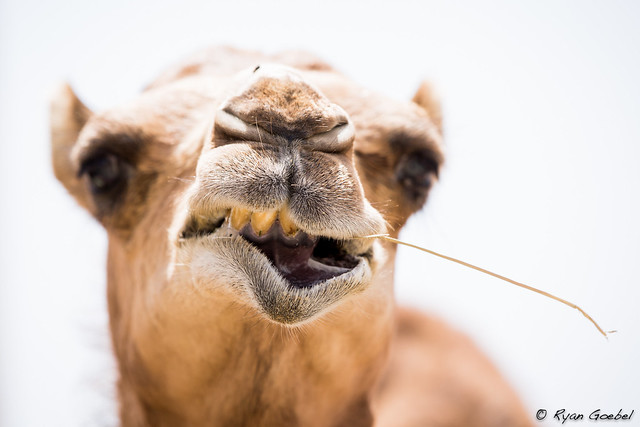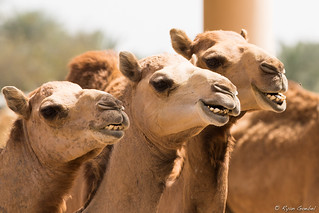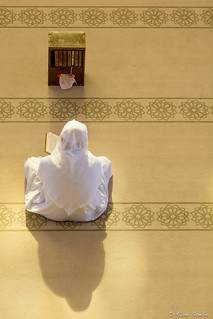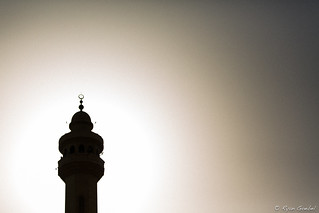
As the "Arab Spring" spread through the Middle East, Bahraini citizens began their own uprising in February of 2011 with hope of gaining more political freedom and more respect for human rights from the monarchy. These protests and riots are still breaking out on a regular basis in this small island country in the Persian Gulf. More than 80 people have died in Bahrain during two years of political unrest. However, during my recent trip to Bahrain, everything was quiet.
As you may have guessed, Bahrain was not in the original plans for my Kilimanjaro-climbing trip. When booking my flights to/from Nairobi using frequent flyer miles, I ended up with a three-day stopover in Dubai. At the time, I was thrilled since I had never been to Dubai and was curious about seeing Burj Khalifa, the tallest building in the world, as well as some of the other architectural gems of the gulf city-state. Little did I know that two months after confirming my Nairobi flights, I would end up on a flight for work that included a 19-hour Dubai layover that was more than enough time for me to get a taste of the overdone Middle Eastern excess of the city. Immediately, I began to brainstorm other alternatives for my Dubai stopover.
Where else could I go in the region so I don't have to waste three entire days in Dubai? Abu Dhabi? Kuwait? Qatar? Wait!.... Jordan isn't that far away, and I've always wanted to see Petra. Maybe the time is now!
In the process of looking flights from Dubai to Amman, Jordan, I stumbled upon a flight on Gulf Air that had a 9am to 6pm layover in Bahrain. Having never been to Bahrain, I decided a layover with this perfect midday timing was an ideal excuse to see this tiny country.
![by Bahrain in pictures [CC-BY-SA-3.0 (http://creativecommons.org/licenses/by-sa/3.0)] via Wikimedia Commons](http://upload.wikimedia.org/wikipedia/commons/6/6d/Protesters_fests_toward_Pearl_roundabout.jpg) |
| by Bahrain in pictures [CC-BY-SA-3.0 (http://creativecommons.org/licenses/by-sa/3.0)] via Wikimedia Commons |
Since my priorities for this three-and-a-half week trip were Mount Kenya and Mount Kilimanjaro, I did very little research about travel in Bahrain. I basically knew: Bahrain is a small island nation connected to Saudi Arabia by a bridge, Saudis like to visit Bahrain on the weekends since Bahrain has looser liquor laws, and Manama has a cool skyscraper with wind turbines integrated into the design. I knew I didn’t really have the time to plan out my full day in the country effectively, so I hired a private tour guide service that I found on TripAdvisor.
By Bahrain in pictures , via Wikimedia Commons
Upon arrival at Bahrain International Airport, I was told that I had to wait while the immigration police ran a background check on my passport since this was my first time in Bahrain. This didn’t worry me too much, since the guy in front of me was in the same situation. I just hoped that it wouldn’t delay my tour by too long. Luckily, about 15 minutes later, my passport was returned to me, and I was on my way out of the airport.
On the drive from the airport, Hadi, my guide, told me some of the highlights of the country and gave me a brief rundown on the history and demographics of Bahrain. Although I had already chosen a tour from the company’s website that included photo stops at the Bahrain World Trade Center and Bahrain Financial Harbor, I told the guide that I was particularly interested in photographing these modern skyscrapers. He acknowledged my request and then proceeded to tell me that we’d first be going to a museum and then a camel farm. I can’t say that either was on my “must see” list, but he convinced me that the Bahrain National Museum was one of the best in the region. I reluctantly agreed after he told me that we didn’t really have time to drive out to the desert to see the A’Ali Burial Mounds, but the museum had an excellent display about them.
[Oddly enough, after finishing my tour, I reread the tour company’s webpage and saw that the A’Ali Burial Mounds were located on the way to the camel farm.]
 |
| From potomo's Flickr photostream Licensed via Creative Commons [CC BY-ND 2.0] |
Thankfully, there is some hope to preserve the remaining burial mounds. In 2008, Bahrain successfully placed 11 of the burial sites on the World Heritage tentative list, which is the first step a country can make to get a site considered for inclusion on the list. I can only hope that the World Heritage Convention adds the Bahrain burial mounds to its protected list.
When we showed up at the Bahrain National Museum, there wasn’t anyone sitting at the front desk, so Hadi decided we should just walk in. The museum does have great exhibits documenting the country’s history from prehistoric times to the present with explanations posted in both Arabic and English. The exhibits on the burial mounds and on the traditional pearling industry were indeed interesting. I would have preferred that my guide just let me roam around the museum on my own for an hour or so, but instead he insisted on showing me his favorite sections. Not being much of a museum person in the first place, I found myself getting bored fairly quickly, especially as my guide attempted to read the English placards out loud to me. This proved only two things to me: 1) My guide could speak English well, but reading it was another story. 2) He was pretty clueless about any history that pre-dated Islam.
On our way out of the museum, there was a guy sitting at the front desk. I’m sure we could have walked right out the door without ever buying an entrance ticket, but Hadi did the right thing and explained to him that we didn’t pay on the way in because no one was at the desk.
When we got to the car, Hadi announced that we would go to the camel farm next. I thought about telling him that I wasn’t really interested in the camel farm, but then decided that it may be worth it for some close-up photos of camels.
Driving through central Manama, Hadi explained that the city was especially quiet since it was a Saturday. Bahrainis tend to stay up late on Friday nights and enjoy an easy Saturday. Downtown was so quiet that I had to wonder if any of it also had to do with the recent riots.
Hadi pointed out the World Trade Center, Financial Harbor, and a few other notable buildings as we drove by them. I reiterated the fact that I was interested in stopping to photograph them at some point on our tour. Hadi replied that parking was difficult in the area (despite the city being almost empty on this particular Saturday morning), but we could stop somewhere for the photos later.
 |
| From Al Jazeera English's Flickr photostream Licensed via Creative Commons [CC BY-SA 2.0] |
Bahrain initially earned its riches through the pearling industry and had a large pearl monument built in 1982 to commemorate the nation's history of pearl cultivation. However, during my quick internet research, I seemed to have missed the fact that this monument also became the center of the Bahraini uprising, and on March 18, 2001, the government announced that the monument had been "violated" and "desecrated" by the "vile" anti-government protests and had to be "cleansed". In other words, it was destroyed.
 The Al-Janabiya camel farms are located along the King Fahad Causeway, which is the highway connecting Bahrain to Saudi Arabia. Upon arrival at the farm, there weren’t any tickets or attendants, only a sign listing rules for visitors, such as “Don’t feed the camels” and “Keep a safe distance when photographing the camels”. There were probably close to 100 camels at the farm, separated into different groups based on age and gender. All of the camels were tied with chains around their ankles, which gave the place more of a camel prison look than of a camel farm look. It was unclear what all these camels are actually used for or what they are doing on this farm. After walking around and taking more than enough close-up photos of camels, Hadi asked me if I was hungry and wanted to go to lunch next.
The Al-Janabiya camel farms are located along the King Fahad Causeway, which is the highway connecting Bahrain to Saudi Arabia. Upon arrival at the farm, there weren’t any tickets or attendants, only a sign listing rules for visitors, such as “Don’t feed the camels” and “Keep a safe distance when photographing the camels”. There were probably close to 100 camels at the farm, separated into different groups based on age and gender. All of the camels were tied with chains around their ankles, which gave the place more of a camel prison look than of a camel farm look. It was unclear what all these camels are actually used for or what they are doing on this farm. After walking around and taking more than enough close-up photos of camels, Hadi asked me if I was hungry and wanted to go to lunch next.
Hadi took me to a small outdoor restaurant tucked into one of the narrow alleyways in the old section of central Manama near Bab al-Bahrain (The Gateway of Bahrain). The same Pakistani family has supposedly run the restaurant for several generations. We had some vegetable curry and lamb biryani, which were both quite delicious. Unfortunately, I didn’t take note of the name of this restaurant or its exact location.
After lunch, we took a quick walk through the souq, which like the rest of the city, seemed eerily quiet on this particular day. I probably should have taken a photo of Bab al-Bahrain, but I wasn’t satisfied with the lighting when we walked by it. Interestingly enough, Bab al-Bahrain used to lie near the seafront when it was built in 1945. However, due to extensive land reclamation, the building is now several kilometers from the sea.
Our next stop was going to be the Al-Fateh Grand Mosque. Driving down King Faisal Highway, Hadi slowed down the car and said, “There’s not much traffic today. I’ll slow down so you can get your photo of the World Trade Center.” I excitedly dug my camera out of the bag between my feet. Then, I pressed the button to open the window, and…… nothing happened. Hadi informed me that “Sorry, that window doesn’t work.” Since we were in the middle of highway, I didn’t have time to complain. I just took some quick shots through the window. I thought that I got an angle that avoided a glare from the sun, but after reviewing the shots on my laptop later at the airport, I realized there was still a glare visible in all the photos. I guess my award-winning photo of the Bahrain World Trade Center just wasn’t meant to be.
Like most gulf countries, Bahrain experienced a building boom in the late 90’s early 00’s. Land was being reclaimed from the sea, sometimes in creative shapes like a horseshoe. Magnificent skyscrapers were being built with designs of which had never seen before. There were no limits.
… And then, like most of the world, it was caught off guard when the global economy crashed in 2008. Although some of the land reclamation and skyscraper construction was complete, many of the projects were left abandoned when the financial backers for the projects either went bankrupt or pulled out. Thankfully, one of the more innovative ones, the World Trade Center and its integrated wind turbines, was completed before the economy soured too much.
Having lived and worked in Muslim-majority countries (Malaysia and Indonesia) for nearly ten years now, as well as having traveled extensively, I didn’t have very high expectations for a mosque that is younger than me. Upon arrival, I was asked to remove my shoes, which is usual etiquette inside mosques. I was told that an English language tour just began, so I was quickly shuffled off to join it. Hadi said he was going to take the time to pray, and he’d meet back up with me after my tour finishes.
 Our mosque guide was a 20-something-year-old guy that was originally from Uzbekistan. He came to Bahrain to work another job, but volunteers to give mosque tours in his free time. He spoke excellent English, and it was apparent from the beginning of the tour that he really enjoyed being a tour guide. His enthusiasm seemed truly genuine. As he led us into the central prayer room, he shared plenty of facts about the mosque and its construction, including that it has the world’s largest fiberglass dome and many of the building materials were imported from exotic places like Italy, Austria, and Scotland. He then proceeded to explain some of the basics of Islam, including what their main prayers are (in both Arabic and English). Next, he asked two of the other guys in the group to stand shoulder-to-shoulder with him so he could show us how Muslims pray. I was so glad he didn’t choose me, since it was entertaining to watch the look on the other guys’ faces as he led them step by step through the basic prayer movements, including getting down on their hands and knees in prostration. Although it may have been funny to watch the two non-Muslim guys prostrate, it was actually the best demonstration of Islam and how Muslims pray that I had ever seen.
Our mosque guide was a 20-something-year-old guy that was originally from Uzbekistan. He came to Bahrain to work another job, but volunteers to give mosque tours in his free time. He spoke excellent English, and it was apparent from the beginning of the tour that he really enjoyed being a tour guide. His enthusiasm seemed truly genuine. As he led us into the central prayer room, he shared plenty of facts about the mosque and its construction, including that it has the world’s largest fiberglass dome and many of the building materials were imported from exotic places like Italy, Austria, and Scotland. He then proceeded to explain some of the basics of Islam, including what their main prayers are (in both Arabic and English). Next, he asked two of the other guys in the group to stand shoulder-to-shoulder with him so he could show us how Muslims pray. I was so glad he didn’t choose me, since it was entertaining to watch the look on the other guys’ faces as he led them step by step through the basic prayer movements, including getting down on their hands and knees in prostration. Although it may have been funny to watch the two non-Muslim guys prostrate, it was actually the best demonstration of Islam and how Muslims pray that I had ever seen.
As a whole, I was truly impressed with the Al-Fateh mosque tour and would highly recommend it to anyone who is in Bahrain, regardless of whether you are interested in Islam or mosques. I know my words probably don’t make it sound that great, but it was a very interesting and educational tour (without being boring).
After the tour was complete, the guide offered to answer any questions that we may have about the mosque, about Islam, or about him in general. He also offered us free Korans (in English), as well as several free pamphlets on the religion. Since I already had a free copy of the Koran, I took a pamphlet called “Who is Mohammed?”, thanked the guide, and went to the front of the mosque to reunite with Hadi.
Back in the car, I asked, “So, what’s next?” I was hoping that Hadi would say that we are going back to the World Trade Center or Financial Harbor. However, that was not the case. I really wasn’t meant to get great photos of those buildings.
“We need to start heading back towards the airport. But, on the way, we will stop at the Sheikh Isa Bin Ali Al-Khalifa historic house. It’s in Muharraq, which is in the same area as the airport.”
Although the Sheikh’s former house was an interesting look into how rich Bahrainis lived in the 19th century, it would have been much better if there were some furniture in the house and some placards on the walls to explain what each room was used for.
I’m not sure what it was about Bahrain, but even with my subpar tour guide and the fact that I missed out of some of the better sites of the city, I was heading back to the airport with good thoughts about this place. I actually enjoyed my layover here, and I can’t place my finger on why that is. Maybe it was something about the welcoming feel of the Al-Fateh mosque tour that made me leave with a peaceful feeling.
My suggestion is that anyone with a layover on Gulf Air doesn’t just hang out at the airport, but go into the city. Although it might not be as glamorous as Dubai, a Bahrain stopover is worth it. It seemed friendlier and more open to foreigners (and not just our wallets) than most of the other gulf countries. However, if you do go, just get a taxi and go where you want. Don’t bother with an overpriced tour guide like I did.
With the current political turmoil and ongoing demonstrations, I don’t know what the future holds for Bahrain. I’d like to think that the people of Bahrain will continue to gain more personal freedoms, and the country as a whole maintains its openness to foreigners and diversity as it has for centuries.
[An interesting side note: The current Bahraini ambassador to the United States is a Jewish woman and the ambassador to Great Britain is a Christian woman. This would be unheard of anywhere else in the Arab world.]
[If nothing else, Bahrain has inspired my longest blog post to date. Thank you for reading this far.]



No comments:
Post a Comment